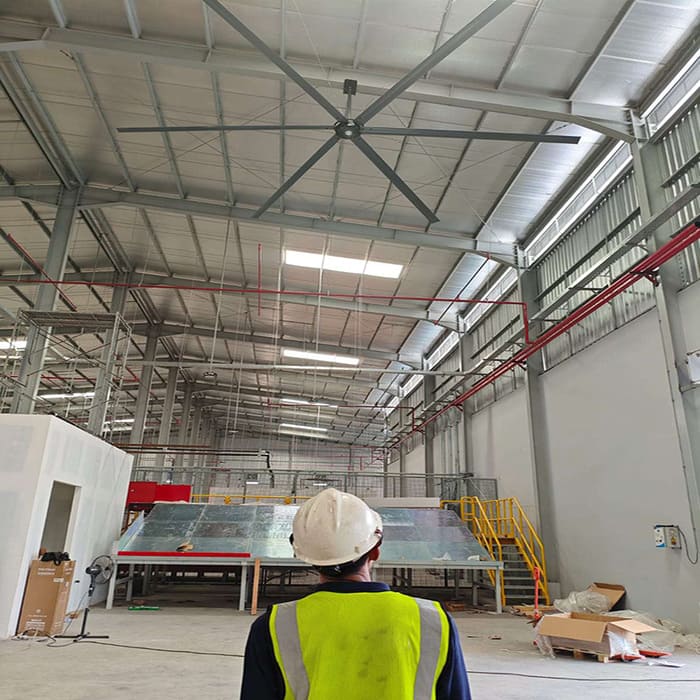With the arrival of summer, the average temperature often exceeds 32 degrees Celsius. For large warehouses, ventilation and cooling are unavoidable topics. On the one hand, maintaining a cool environment can reduce workers' risk of heat stroke and maintain work efficiency. On the other hand, for the goods in the warehouse, the overly dry environment in summer may cause a fire.
Traditional air conditioning is unsuitable for most warehouses because large warehouses are often semi-open. Even for fully enclosed warehouses, excessive space will reduce the cooling effect of air conditioning and increase energy consumption costs significantly.
So, is there any other way to cool down without using traditional air conditioning? Yes, this article introduces a comprehensive cooling system for warehouses. This solution can help you reduce equipment costs and energy costs while ensuring that the warehouse remains cool.
Natural ventilation: Harnessing the power of airflow
Natural ventilation is the simplest and most economical way to cool a warehouse. By strategically opening windows and doors and placing vents, you can create cross ventilation, exhausting hot air, and bringing in cooler outside air.
Specifically:
- Install louvered vents or rooftop turbines to promote air circulation.
- Open windows and doors on both sides of the warehouse to create a breeze.
- Use shade structures or reflective roofs to reduce heat buildup.
HVLS (High Volume Low Speed) Fans
When natural airflow isn't enough, HVLS Fans come in handy. These giant fans (with blades up to 24 feet wide!) move large volumes of air at low speeds, breaking up the airflow in the room and preventing heat from building up.

Why choose HVLS Fans?
- Energy saving: Energy saving is the core meaning of HVLS, which can save up to 60% energy compared with traditional air conditioners.
- Wide coverage: A single large-diameter fan can provide cooling for up to 20,000 square feet (about 1777 square meters).
- Year-round use: The direction of the blades can be reversed in winter to redistribute warm air.
- Quiet: Because its design adopts a low-speed movement method, the noise is very low. For example, the fan noise decibel of the CorTec fan can be controlled at 43db (normal AC sound is 63db)
Evaporative cooling system
Air coolers (evaporative coolers) are ideal for dry climates. They work by drawing hot air through a moisture-saturated damp pad, cooling it by evaporation, and circulating the cooled air.
Benefits of Evaporative Cooling:
- Cost savings: 75% less energy than air conditioning.
- Environmentally friendly: No refrigerants required, just water and airflow.
- Portable options: Mobile units for local cooling.
- Pairing an evaporative cooler with an HVLS Fan can extend its cooling range. For example, place the air cooler near an open door and let the HVLS Fan move the cool air throughout the warehouse.
Local cooling solutions
Not every corner of a warehouse requires the same level of cooling. Portable air coolers or high-velocity floor fans can provide targeted cooling for workstations, machines, or high-traffic areas.
When to use spot cooling:
- Cooling employees in fixed locations, such as packaging stations.
- Protecting heat-sensitive equipment or products.
- Flexible and cost-effective, these solutions ensure critical areas remain efficient without overcooling the entire space.
Dehumidification
High humidity can make the feeling of stuffiness even more intense. Even a warehouse with a moderate temperature can become unbearable if the humidity soars, creating the illusion of sweating. Industrial dehumidifiers can solve this problem by removing excess moisture and creating a more comfortable environment.
Importance of Dehumidifiers:
- Reduces 'stuffy' conditions that stress HVAC systems.
- Prevents mold, corrosion, and product damage.
- Uses with fans or coolers to enhance perceived coolness.
- Industrial-grade models are designed for large spaces and can run continuously, making them a must-have in humid regions such as Southeast Asia.
Conclusion: Comprehensive use to maximize comfort
Cooling down a warehouse without air conditioning is not a one-shot process, but requires a combination of strategies. Based on natural ventilation, using large energy-saving fans to enhance airflow, supplemented by evaporative coolers to increase cooling capacity, using portable equipment to cover local areas, and using industrial dehumidifiers to control air humidity, the overall space problem can be reduced very quickly.
Such a comprehensive cooling system can save your warehouse a huge amount of energy costs every year, while achieving an effective cooling effect. This is why this type of equipment is widely sold in Southeast Asia, South America, Africa, and other regions.
By adopting these methods, you can significantly reduce your energy bills, improve working conditions, and protect your inventory. Are you ready to transform your warehouse? Contact us to get a customized warehouse cooling system plan for you!
